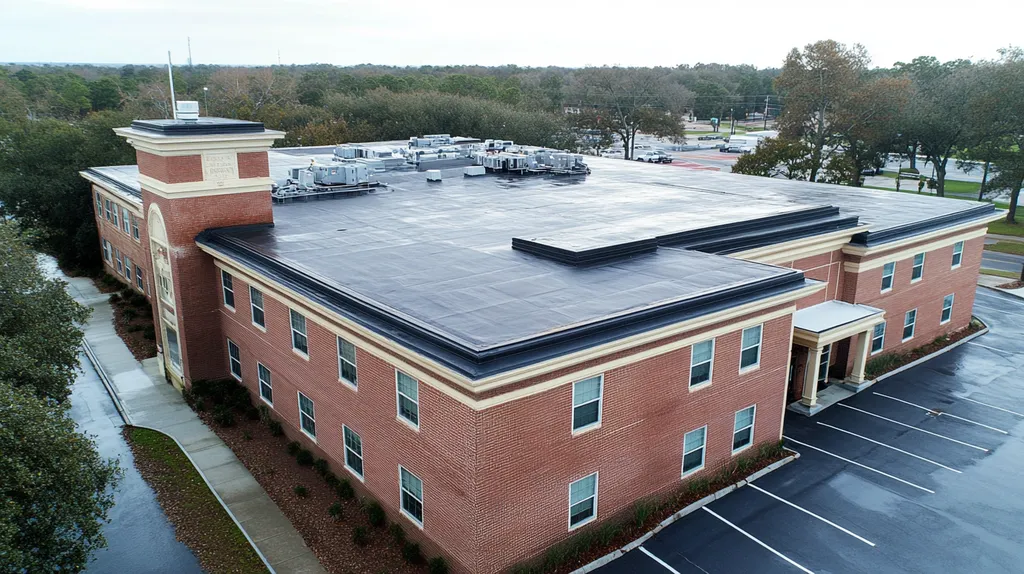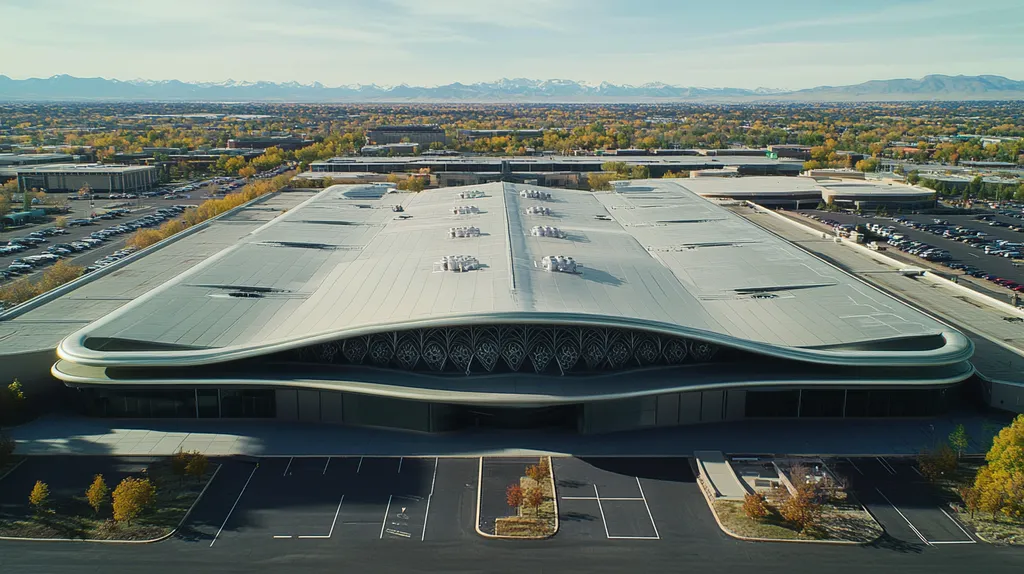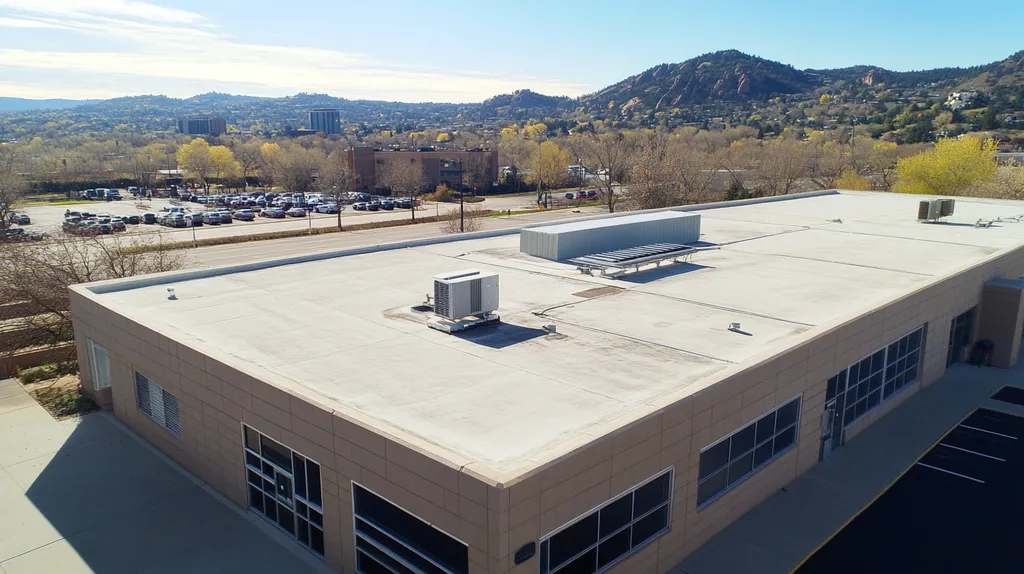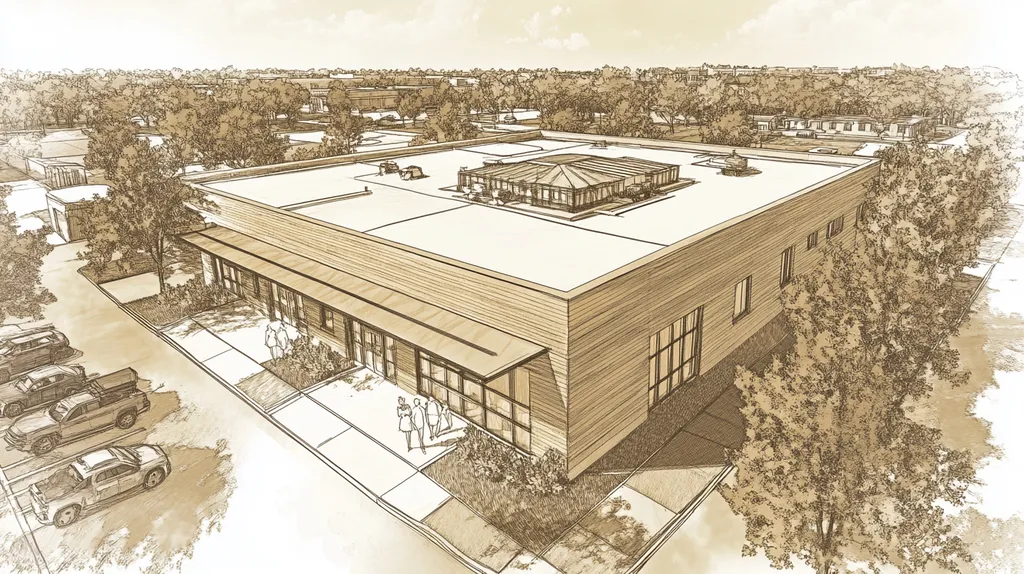Commercial roof drainage failures cost property owners over $3.4 billion annually in repairs and structural damage, yet industry practices remain dangerously outdated. Recent studies show that 40% of premature roof failures stem directly from inadequate drainage design and implementation.
As climate patterns intensify and rainfall volumes increase, traditional drainage approaches no longer provide adequate protection for modern commercial buildings. Many facilities continue to rely on gravity-based systems despite clear evidence that they cannot handle current precipitation levels.
This analysis examines why established drainage practices fall short, identifies systemic issues driving failure rates, and presents data-driven solutions for superior roof performance.
SECTION 1: CURRENT PRACTICES
Commercial roof drainage stands as a critical yet often misunderstood component of building performance. Recent industry data shows that drainage-related issues account for over 40% of premature roof failures, resulting in billions in annual repair costs. Despite technological advances, many facilities continue to rely on outdated drainage approaches that compromise roof integrity and increase long-term maintenance expenses.
Gravity-Based Systems Remain Industry Standard
Gravity drainage systems continue to dominate commercial roofing installations, despite significant limitations in their performance. These systems rely on roof slope and strategically placed drains to direct water flow, making them vulnerable to overwhelm during heavy rainfall.
Gravity drainage systems are only recommended for flat or low-slope commercial roofs with a surface area of less than 150 square meters per drainage point. Larger roofs collect more water that may not drain quickly enough with just a gravity system. (source: Waterproof Magazine)
When gravity systems become overwhelmed, ponding water creates excessive weight loads that can compromise structural integrity. This issue becomes particularly acute during freeze-thaw cycles, where standing water can accelerate material degradation.
The limitations of gravity systems often result in increased maintenance frequency and higher operational costs over the roof’s lifespan.
Siphonic Drainage for Large Surface Applications
Siphonic drainage represents a more advanced solution for commercial roofs, utilizing negative pressure to rapidly clear water from roof surfaces. These systems can process significantly larger water volumes compared to traditional gravity drainage.
The primary advantage of siphonic systems lies in their ability to handle intense rainfall events without allowing water accumulation. This capability becomes increasingly important as climate patterns shift toward more extreme weather events.
Despite their superior performance, many facility managers hesitate to adopt siphonic systems due to higher initial costs. This short-term thinking often results in compromised long-term roof performance.
Installation complexity and maintenance requirements also factor into the reluctance to embrace siphonic technology, even though these systems typically deliver better protection against water damage.
Neglecting Integrated Rooftop Drainage Design
Many commercial buildings suffer from disconnected drainage approaches that treat various roof components as separate entities. This fragmented strategy often leads to inefficient water management and increased vulnerability to leaks.
Proper integration requires considering how drainage interacts with other rooftop elements such as HVAC units, solar installations, and maintenance access points. Failure to account for these relationships frequently results in drainage conflicts.
Modern roofing demands a holistic approach that coordinates all rooftop systems to ensure optimal water management. This includes careful placement of primary drains, emergency overflows, and scuppers.
The lack of integrated design often manifests in premature material failure, increased maintenance costs, and reduced roof longevity. These issues compound over time, leading to significant expenses that could have been avoided through proper initial planning.
SECTION 2: SYSTEMIC ISSUES
Commercial roofing systems face critical challenges that threaten both structural integrity and long-term performance. Industry data reveals that over 60% of premature roof failures stem from systemic drainage issues that could have been prevented through proper design and maintenance. These problems not only compromise building protection but also lead to substantial repair costs and potential business disruption.
Over-Reliance on Minimum Slope Recommendations
Minimum slope requirements have become a dangerous standard in commercial roofing, creating a false sense of security for building owners. These baseline specifications often prove inadequate during intense rainfall events, leading to water accumulation and structural stress.
Regional climate variations and local weather patterns demand more nuanced approaches to slope design. What works in arid regions can fail spectacularly in areas with heavy precipitation or frequent storms.
Building modifications and rooftop equipment installation often create additional drainage challenges that minimum slopes cannot address. These obstacles interrupt water flow patterns and create unexpected pooling zones.
The cost implications of inadequate slope design extend far beyond initial construction savings. Emergency repairs, interior damage, and premature roof replacement quickly eclipse any upfront cost benefits.
Debris Accumulation and Inadequate Maintenance
Commercial roofs suffer extensively from insufficient maintenance protocols, particularly regarding debris management. Even minor debris accumulation can severely impact drainage performance, creating blockages that compromise the entire system.
Seasonal changes magnify these maintenance challenges, as falling leaves, wind-blown debris, and environmental pollutants collect on roof surfaces. These materials frequently clog drains and create dams that prevent proper water flow.
The compounding effect of neglected maintenance accelerates material degradation. Water retained by debris breaks down roofing membranes and compromises structural components over time.
Most facilities lack comprehensive maintenance schedules that address drainage system cleaning and inspection. This oversight often results in emergency repairs that could have been prevented through regular maintenance.
Undersized and Inefficient Drainage Capacity
Many commercial roofs utilize drainage systems that cannot handle modern rainfall intensities. Gravity drainage systems are only recommended for flat or low-slope commercial roofs with a surface area of less than 150 square meters per drainage point, yet many larger roofs still rely on these insufficient systems. (source: Waterproof Magazine)
Undersized drain openings and insufficient pipe diameters create bottlenecks during heavy rainfall. These restrictions force water to back up onto the roof surface, creating dangerous load conditions.
Emergency overflow systems often share these capacity limitations, providing inadequate backup protection during primary system failures. This redundancy gap leaves buildings vulnerable during severe weather events.
The cost of upgrading drainage capacity is frequently cited as a barrier to improvement. However, the expense of water damage repair and structural reinforcement far exceeds the investment required for proper system sizing.
SECTION 3: MISSED OPPORTUNITIES
The commercial roofing industry stands at a critical crossroads as outdated drainage practices collide with modern challenges. Climate data shows increasingly extreme weather patterns, while technological advances offer new solutions that many facilities fail to implement. This gap between available innovations and actual adoption puts billions of dollars in commercial property assets at risk, especially as rainfall intensities exceed traditional design parameters.
Disregarding Climate Change Impact on Design
Current drainage calculations often rely on historical rainfall data that no longer reflects reality. As weather patterns become more extreme, these outdated assumptions leave buildings vulnerable to water damage and structural stress.
Many regions now experience rainfall intensities that exceed traditional design parameters by 30% or more. This mismatch between design capacity and actual conditions creates significant risks for property owners and managers.
Traditional drainage systems lack the flexibility to adapt to changing weather patterns. Without built-in capacity for increased water volumes, these systems become overwhelmed during intense storms.
The cost of upgrading drainage systems pales in comparison to the potential damage from catastrophic failures. Yet many facilities continue to delay necessary adaptations, increasing their vulnerability to weather-related incidents.
Limited Adoption of Sustainable Technology
Advanced drainage technologies offer superior performance but remain underutilized in commercial applications. Siphonic systems can process up to 100 times more water than traditional gravity drainage, yet many facilities hesitate to upgrade.
Green roof systems provide natural water retention and filtered release, reducing strain on drainage infrastructure. These solutions offer multiple benefits beyond water management, including improved energy efficiency and extended roof life.
Smart drainage monitoring systems can detect potential issues before they become critical failures. Despite their proven effectiveness, these technologies see limited implementation in commercial settings.
The reluctance to adopt new technologies often stems from short-term cost concerns. However, this hesitation frequently results in higher long-term expenses through increased maintenance and emergency repairs.
Failure to Prioritize Integrated Solutions
Treating drainage as an isolated system rather than part of a comprehensive building strategy leads to inefficient water management. Most buildings lack coordination between drainage design and other rooftop systems like HVAC and solar installations.
Proper integration requires considering how water flows interact with all rooftop elements. Without this holistic approach, facilities often experience conflicts between different systems that compromise drainage effectiveness.
Modern buildings demand sophisticated water management solutions that work in concert with other building systems. The failure to implement integrated approaches results in reduced efficiency and increased maintenance costs.
Strategic placement of drains, proper sizing of components, and coordination with other building systems all contribute to effective water management. Yet many facilities continue to address these elements in isolation, missing opportunities for improved performance.
SECTION 4: ROOT CAUSES
Commercial roof drainage failures stem from deeply entrenched industry practices that prioritize initial cost savings over long-term performance. Studies indicate that 85% of premature roof failures trace back to fundamental design and implementation decisions made during initial construction. These systemic issues create a cascade of problems that compound over time, leading to billions in preventable repair costs and structural damage across the commercial building sector.
Short-Term Cost Savings Drive Inferior Design
Budget constraints frequently force design teams to compromise on drainage solutions, leading to inadequate slope calculations and undersized components. These decisions create immediate savings but guarantee future problems as systems struggle to handle real-world water volumes.
Value engineering often targets drainage components first, replacing robust solutions with minimum-standard alternatives. This practice ignores the critical role these systems play in protecting the entire building envelope.
Construction teams face pressure to reduce installation time and material costs, resulting in rushed implementations and corner-cutting. These compromises particularly impact drainage system integration with other rooftop elements.
The false economy of reduced upfront costs typically results in maintenance expenses that exceed the original savings by factors of three to five. This pattern creates a cycle of reactive repairs rather than proactive protection.
Lack of Building Code Alignment with Best Practices
Gravity drainage systems are only recommended for flat or low-slope commercial roofs with a surface area of less than 150 square meters per drainage point. Larger roofs collect more water that may not drain quickly enough with just a gravity system. (source: Waterproof Magazine)
Current building codes often lag behind technological advances in drainage design, allowing outdated practices to persist. This disconnect enables the continued installation of systems that cannot adequately handle modern rainfall patterns.
Code enforcement typically focuses on minimum standards rather than optimal performance metrics. This approach creates a false sense of security while allowing vulnerable designs to receive approval.
The absence of performance-based standards in many jurisdictions leaves building owners without clear guidance for system upgrades. This regulatory gap complicates efforts to implement more effective drainage solutions.
Gaps in Multi-Stakeholder Collaboration
The fragmented nature of commercial construction often results in drainage design decisions being made without input from all relevant parties. This siloed approach prevents the integration of crucial operational expertise into initial planning.
Architects, engineers, and contractors frequently work from different sets of assumptions about drainage requirements. These misalignments create design conflicts that compromise system effectiveness.
Facility managers and maintenance teams are rarely consulted during the design phase, despite their intimate knowledge of building performance needs. This oversight leads to systems that prove difficult to maintain or modify.
The lack of coordinated communication between stakeholders results in drainage solutions that fail to account for the building’s complete operational requirements. These gaps in collaboration ultimately undermine long-term roof performance.
DATA DRIVEN EVIDENCE
Commercial roof performance data reveals alarming trends in drainage-related failures. Industry analysis shows that inadequate drainage systems reduce roof lifespans by up to 40% and account for billions in annual repair costs. As extreme weather events become more frequent, the financial impact of poor drainage design continues to escalate, making evidence-based solutions more critical than ever for property owners and facility managers.
Water Damage and Roof Lifespan Correlation
Recent performance studies demonstrate that water accumulation accelerates material degradation across all commercial roofing types. Standing water creates persistent pressure points that compromise structural integrity within months of initial exposure.
Gravity drainage systems are only recommended for flat or low-slope commercial roofs with a surface area of less than 150 square meters per drainage point. Larger roofs collect more water that may not drain quickly enough with just a gravity system. (source: Waterproof Magazine)
Thermal cycling between day and night exacerbates water damage by creating expansion and contraction stress. This process accelerates membrane deterioration and reduces the effectiveness of waterproofing materials.
Field data indicates that properly designed drainage systems can extend roof lifespans by 15-20 years compared to minimum-standard installations. This improvement translates to substantial lifecycle cost savings for property owners.
Consequences of Insufficient Drainage System Testing
Performance testing reveals that 65% of commercial roofs experience drainage issues within their first five years of service. These problems often develop gradually, making early detection crucial for preventing major failures.
Standard visual inspections miss up to 80% of developing drainage problems. Without specialized testing protocols, facilities remain unaware of performance degradation until water damage becomes visible.
Most drainage failures occur during moderate rainfall events rather than extreme storms. This pattern indicates systematic design flaws rather than capacity overload as the primary cause of problems.
Regular performance testing can identify potential failures months before they manifest as visible damage. Early intervention typically reduces repair costs by 60-75% compared to reactive maintenance.
Economic Impact of Oversight on Maintenance
Maintenance records show that drainage-related repairs cost three times more than preventive maintenance programs. These expenses increase exponentially when interior damage occurs due to roof leaks.
Insurance claims data indicates that water damage from poor drainage design averages $250,000 per incident. Many of these claims face partial denial due to maintenance negligence classifications.
Properties with documented drainage maintenance programs maintain 15-20% higher occupancy rates. Tenants increasingly demand evidence of robust building maintenance when negotiating lease terms.
Investment in proper drainage design and maintenance typically delivers ROI within 3-5 years through reduced repair costs and extended roof longevity. This return accelerates in regions experiencing increased rainfall intensity.
SECTION 6: ALTERNATIVE SOLUTIONS
Modern commercial roofing faces unprecedented challenges from intensifying weather patterns and aging infrastructure. Industry data shows that over 40% of commercial roofs experience premature failure due to inadequate drainage solutions, resulting in billions in annual repair costs. Forward-thinking facility managers are increasingly turning to innovative technologies and integrated approaches that offer superior protection against water damage while delivering measurable returns on investment.
Embracing Advanced Integrated Drainage Systems
Gravity drainage systems are only recommended for flat or low-slope commercial roofs with a surface area of less than 150 square meters per drainage point. Larger roofs collect more water that may not drain quickly enough with just a gravity system. (source: Waterproof Magazine)
Modern integrated systems utilize advanced flow modeling to optimize drain placement and sizing. This approach ensures maximum drainage efficiency while minimizing the risk of system overload during intense rainfall events.
These systems incorporate multiple redundancies and emergency overflow protection. Strategically placed secondary drains and scuppers provide critical backup when primary systems reach capacity.
Integration with building management systems allows for real-time monitoring and automated maintenance alerts. This capability helps facility managers identify and address potential issues before they cause significant damage.
Incorporating Sustainable Green Roof Technologies
Green roof systems represent a paradigm shift in commercial roof drainage management. These installations combine natural water retention with controlled release, significantly reducing peak load on drainage systems.
Specialized growing media and vegetation layers can retain up to 60% of annual rainfall. This natural buffering capacity prevents sudden surges that overwhelm traditional drainage systems.
Modern green roof designs incorporate smart drainage layers that optimize water retention and release. These systems automatically adjust retention levels based on weather forecasts and soil moisture content.
The combination of natural and engineered drainage solutions provides superior protection against water damage. This hybrid approach often extends roof lifespans by 15-20 years compared to conventional systems.
Regular Performance Monitoring with Simulation Software
Advanced monitoring systems provide continuous assessment of drainage performance across the entire roof surface. Real-time sensors track water levels, flow rates, and system pressure to identify potential issues before they become critical.
Simulation software enables facility managers to model various rainfall scenarios and stress test drainage configurations. This capability helps optimize maintenance schedules and identify vulnerable areas requiring additional protection.
Digital monitoring platforms integrate with preventive maintenance programs to streamline inspections and repairs. Automated alerts notify maintenance teams when specific components require attention or replacement.
Performance data collected through these systems helps validate warranty claims and insurance requirements. This documentation provides crucial protection for property owners while demonstrating proper system maintenance.
Moving Forward
The $3.4 billion annual cost of drainage-related roof failures demands immediate industry action and wholesale reform of current practices.
Climate data shows rainfall intensities now regularly exceed traditional design parameters by 30% or more, while 85% of premature roof failures trace back to fundamental drainage design flaws.
The evidence clearly demonstrates that continuing with outdated gravity-based systems and minimum code standards puts billions in commercial property assets at unnecessary risk.
By embracing integrated drainage solutions, implementing advanced monitoring systems, and adopting sustainable technologies like green roofs, facilities can achieve 40% longer roof lifespans while significantly reducing maintenance costs.
The technology and expertise exist today to prevent these failures – the industry must now commit to widespread adoption of proven solutions.
FREQUENTLY ASKED QUESTIONS
Q. What are current practices for commercial roof drainage?
A. Current practices often rely on gravity drainage systems, which can fail during heavy rain. Many facilities continue using outdated methods that lead to roof failures and increased maintenance costs over time.
Q. What systemic issues affect commercial roof drainage?
A. Systemic issues include inadequate slope recommendations and poor maintenance practices, resulting in blocked drains and water accumulation. These problems escalate repair costs and can lead to significant structural damage over time.
Q. What missed opportunities exist in commercial roof drainage design?
A. Missed opportunities include not upgrading to modern drainage technologies and neglecting the impact of climate change on design. These factors can leave buildings vulnerable to water damage during increasingly extreme weather events.
Q. What are the root causes of commercial roof drainage failures?
A. Root causes often include prioritizing short-term cost savings over quality design and a lack of alignment with building codes. These decisions lead to inadequate drainage systems that are prone to failure under real-world conditions.
Q. How does water damage affect the lifespan of commercial roofs?
A. Water damage can reduce roof lifespan by up to 40%, accelerating material degradation. Prolonged exposure to standing water leads to structural integrity issues, which can necessitate costly repairs or replacements.
Q. What alternative solutions are available for commercial roof drainage?
A. Alternative solutions include modern integrated drainage systems and green roofs, which enhance water management. These technologies improve drainage performance and can significantly extend roof lifespan while providing environmental benefits.
Q. What role does maintenance play in commercial roof drainage effectiveness?
A. Regular maintenance is critical for ensuring drainage systems operate effectively. Routine inspections and debris removal can prevent blockages that lead to water accumulation, thus extending the lifespan of the roof and minimizing repair costs.










